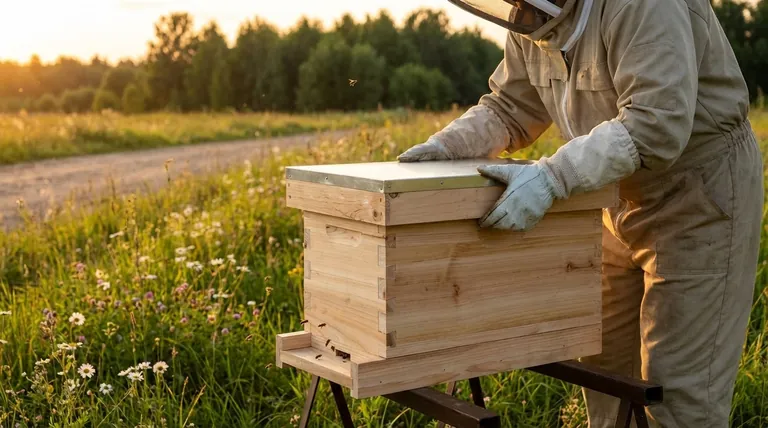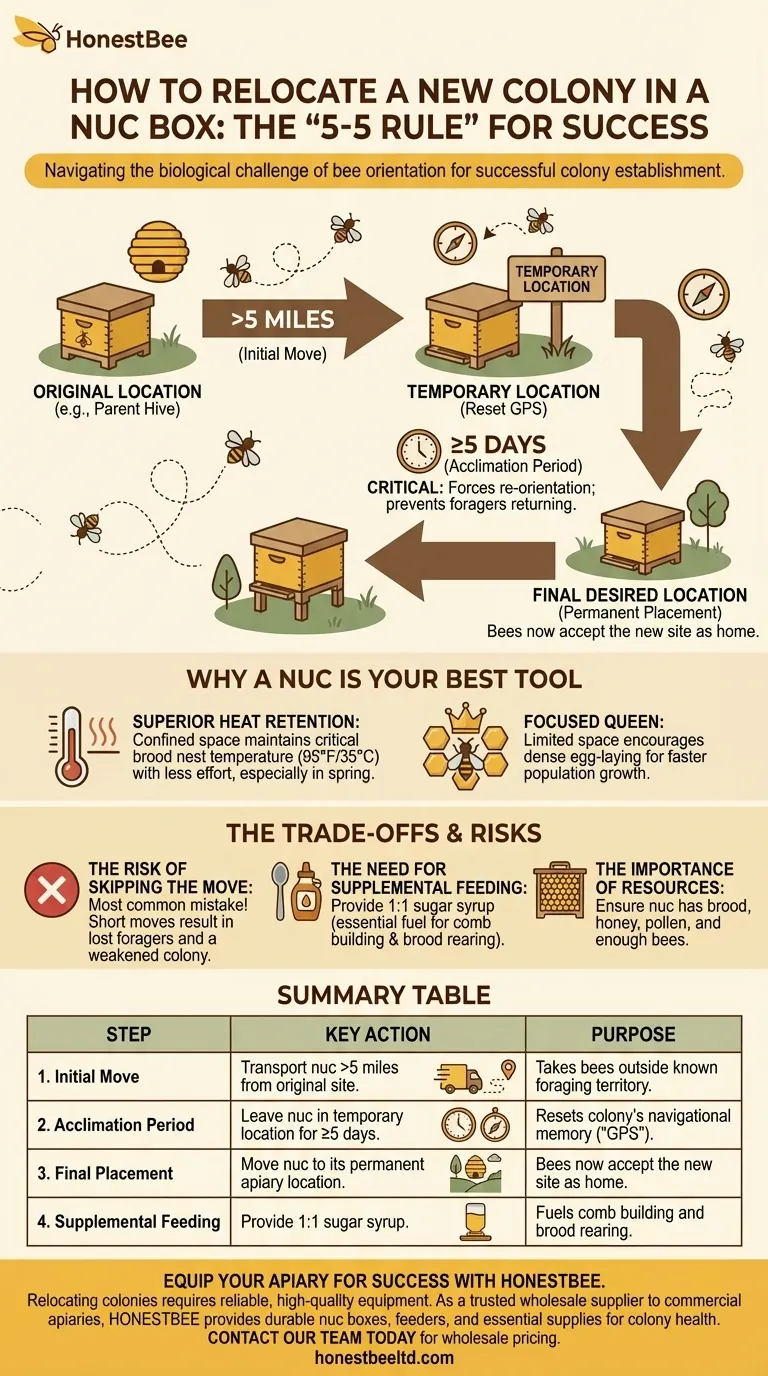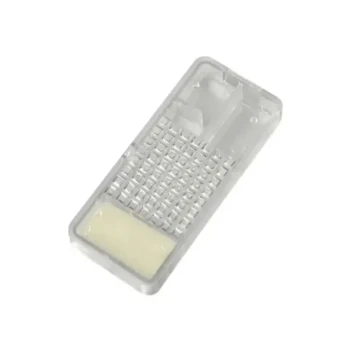To successfully relocate a new bee colony in a nuc box, you must first move the nuc at least five miles away from its original location and leave it there for a minimum of five days. This critical step resets the bees' navigational memory, or "GPS," preventing them from abandoning their new home and returning to the old site. After this period, you can bring the nuc to its final, desired location.
The physical act of moving a hive is simple, but ensuring the bees stay is a biological challenge. Success hinges on understanding and resetting the colony's powerful homing instinct before introducing them to their permanent hive.

The Core Principle: Resetting Bee Orientation
Honey bees are remarkable navigators. Foraging bees create a mental map of their surroundings, locking in the precise location of their hive. Moving the hive a short distance without addressing this internal map is a recipe for failure.
The "5-5 Rule" of Relocation
The most reliable method is to move the nuc box at least 5 miles away from its original location for at least 5 days. This distance and duration are crucial.
The distance ensures the bees are outside their known foraging territory, forcing them to re-orient. The time allows the entire foraging force to acclimate to the idea that the nuc's new, temporary location is "home."
Why This Prevents Colony Loss
If you simply move a nuc from one side of your property to the other, the foragers will exit, orient themselves, and fly directly back to the original hive location. Finding their home gone, they will cluster and perish, depleting the new colony of its vital workforce.
Why a Nuc is Your Best Tool for Establishment
Using a small nuc box for the first few weeks is a strategic decision that dramatically increases the odds of a new colony's survival, especially in the cool weather of spring.
Superior Heat Retention
A small colony in a full-sized hive box struggles to maintain the critical brood nest temperature (around 95°F or 35°C). The nuc's confined space minimizes heat loss, allowing the bees to keep the brood warm with less effort.
A Focused Queen
The limited space encourages the queen to lay eggs in a dense, concentrated pattern. This efficiency leads to a faster population boom, as more brood can be cared for by the existing nurse bees.
Understanding the Trade-offs and Risks
While this method is highly effective, it's important to understand the associated risks and why shortcuts often fail.
The Risk of Skipping the Move
Failing to perform the 5-mile relocation is the most common mistake. Beekeepers who attempt a short-distance move will lose a significant portion of their foraging bees, severely weakening and often dooming the new colony.
The Need for Supplemental Feeding
A new colony is focused on two things: drawing out wax comb and raising brood. Both are incredibly energy-intensive. Providing a 1:1 sugar syrup feed is not optional; it is essential fuel for construction and growth.
The Importance of Resources
A nuc should be started with the right components. It must contain frames of brood in all stages (eggs, larvae, capped), frames of honey and pollen for food, and enough adult bees to cover the frames and care for the queen.
How to Apply This to Your Project
Your exact steps depend on the origin of your new colony.
- If your primary focus is splitting a strong hive on your own property: The 5-mile, 5-day relocation is mandatory to prevent the nuc's foragers from returning to the parent hive.
- If your primary focus is installing a purchased nuc: Confirm with the seller how far away they are. If they are more than 5 miles from your apiary, you can place the nuc in its final position immediately, as the journey has already reset their orientation.
- If your primary focus is colony survival: Always provide supplemental sugar syrup to a new colony in a nuc to fuel their critical initial buildup.
By respecting the bee's biology and providing the right resources, you empower the new colony to not just survive, but thrive.
Summary Table:
| Step | Key Action | Purpose |
|---|---|---|
| 1. Initial Move | Transport nuc >5 miles from original site. | Takes bees outside known foraging territory. |
| 2. Acclimation Period | Leave nuc in temporary location for ≥5 days. | Resets colony's navigational memory ("GPS"). |
| 3. Final Placement | Move nuc to its permanent apiary location. | Bees now accept the new site as home. |
| 4. Supplemental Feeding | Provide 1:1 sugar syrup. | Fuels comb building and brood rearing. |
Equip your apiary for success with HONESTBEE.
Relocating colonies requires reliable, high-quality equipment. As a trusted wholesale supplier to commercial apiaries and beekeeping equipment distributors, HONESTBEE provides the durable nuc boxes, feeders, and essential supplies you need to manage your operations efficiently and ensure colony health.
Let's discuss your specific needs. Contact our team today to learn more about our product range and wholesale pricing.
Visual Guide

Related Products
- 5 Frame Wooden Nuc Box for Beekeeping
- Twin Queen Styrofoam Honey Bee Nucs Mating and Breeding Box
- Automatic Heat Preservation 6 Frame Pro Nuc Box for Honey Bee Queen Mating
- Plastic Transporting Bee Packages and Nuc Boxes for Beekeeping
- Portable Bee Mating Hive Boxes Mini Mating Nucs 8 Frames for Queen Rearing
People Also Ask
- What are the benefits of using nucs for beginning beekeepers? Ensure a Successful First Hive with a Head Start
- What frames should be moved into the queenless hive when requeening with a nuc? Ensure a Successful Queen Introduction
- What are the benefits of moving nuclei around the apiary? Master Strategic Hive Management
- How many frames does a typical wooden nuc box hold? A Guide to Choosing the Right Size
- What is the most common type of standard nuc? The 5-Frame Nuc Explained



















